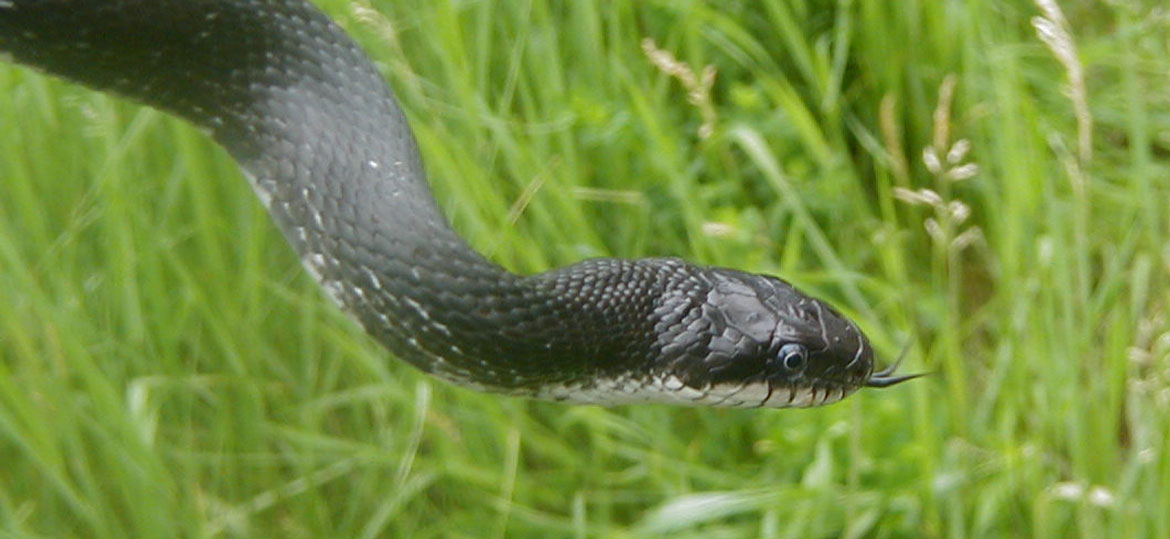
The adult Eastern Ratsnake (Pantherophis alleghaniensis) is black, but usually shows remnants of its juvenile pattern. It is a black and white checkerboard on the front half, and then turns to a solid dark tone towards the tail. The Ratsnake has weakly keeled scales. They are the only "weakly keeled" snakes. Adults may be 5-6 feet long (the longest documented in Vermont is 75 inches). Ratsnakes are great climbers.
Habitat
The Eastern Ratsnake is a wide-ranging snake that can be found east of the Apalachicola and Chattahoochee rivers and Appalachian Mountains from southern Florida to western Vermont. Vermont represents the northeastern edge of the species’ geographic range.
Most ratsnakes in the United States were once considered a single species, the Common Ratsnake (Elaphe obsoleta), that included five subspecies: the Black Ratsnake, Gray Ratsnake, Yellow Ratsnake, Texas Ratsnake, and Everglades Ratsnake. However, genetic analyses led to taxonomic revisions, and today the five subspecies are considered to be three distinct species: the Eastern Ratsnake, Gray Ratsnake, and Western Ratsnake. Only the Eastern Ratsnake occurs in Vermont.
Eastern Ratsnakes occupy a variety of forested and open habitats. These snakes can be found near forest and field edges, rocky outcrops, ledges, as well as in and around old buildings and barns.
Reproduction
Most of Vermont's snakes give live birth, but ratsnakes lay eggs. Between March and May, snakes will begin to emerge from the winter's hibernation. After a few weeks, the Eastern Ratsnakes will begin to seek out a mate, typically in late April, May, and early June.
Males tend to wait for the females to pass through their territory, and by using pheromones, will communicate and initiate the mating process with the female. The male snake will approach the female, line up with her and attempt to wrap his tail around hers with their vents nearly touching. Some males will grasp the female, with his mouth, to hold her in place and prevent her from trying to move away.
The male will then erect his hemipene and insert it into the female's cloaca while several small spines anchor the hemipene firmly. Mating may last only a few minutes or it may span the time of a few hours. Five weeks later, the female will lay 12 to 20 eggs. The female will lay her eggs in a hidden area, under hollow logs or leaves, or in abandoned burrows. The eggs will hatch 65 to 70 days later.
The hatchlings of Eastern Ratsnakes are vigorous eaters and will double their size rather quickly. If conditions are good, females will sometimes produce two clutches of eggs a year.
Diet
Ratsnakes are primarily known as rodent eaters, however, other food preferences do exist. As juveniles, ratsnakes will eat small lizards, baby mice, and an occasional small frog. Adult ratsnakes have a diet mainly consisting of mice and rats, but will also include chipmunks, moles, and other small rodents. Adults will also eat bird eggs and young birds that do not put up a strong fight. Ratsnakes kill their prey by constriction.
Management
All sightings of the Eastern Ratsnake should be reported, because it is at high risk due to very restricted range and few populations throughout the state.
Threatened in Vermont
Eastern Ratsnakes are rare in Vermont, and has been designated a Species of Greatest Conservation Need in Vermont's Wildlife Action Plan and is threatened in Vermont.
